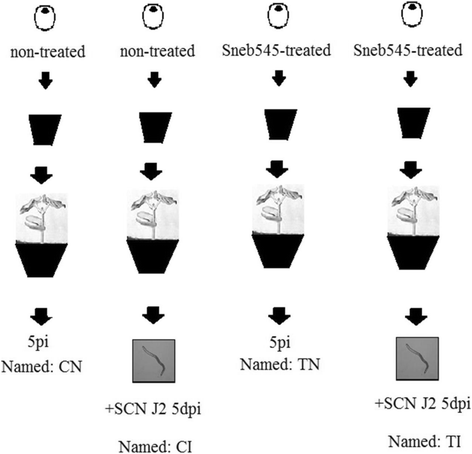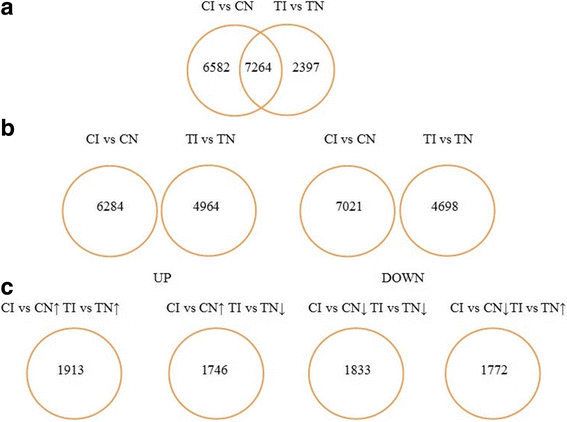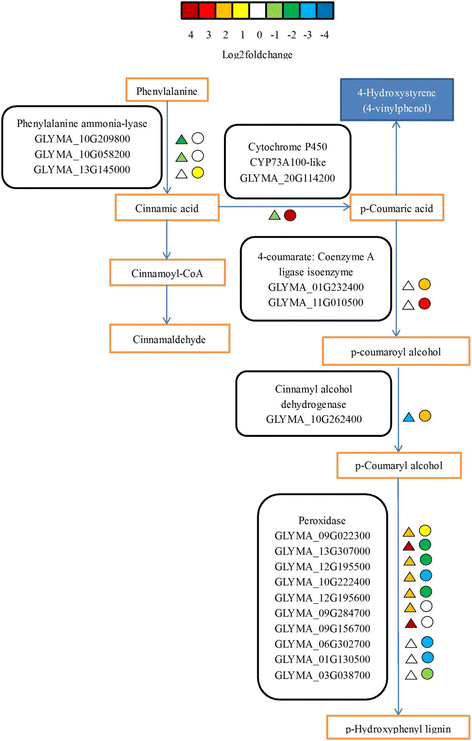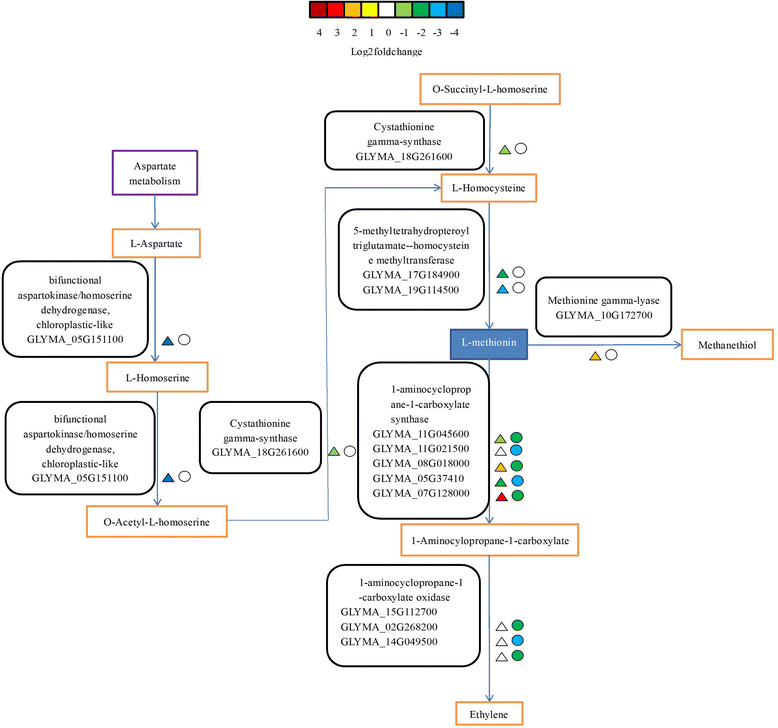Transcriptomic and metabolomic analyses reveal that bacteria promote plant defense during infection of soybean cyst nematode in soybean
- PMID: 29751738
- PMCID: PMC5948838
- DOI: 10.1186/s12870-018-1302-9
Transcriptomic and metabolomic analyses reveal that bacteria promote plant defense during infection of soybean cyst nematode in soybean
Abstract
Background: Soybean cyst nematode (SCN) is the most devastating pathogen of soybean. Our previous study showed that the plant growth-promoting rhizobacterium Bacillus simplex strain Sneb545 promotes soybean resistance to SCN. Here, we conducted a combined metabolomic and transcriptomic analysis to gain information regarding the biological mechanism of defence enhancement against SCN in Sneb545-treated soybean. To this end, we compared the transcriptome and metabolome of Sneb545-treated and non-treated soybeans under SCN infection.
Results: Transcriptomic analysis showed that 6792 gene transcripts were common in Sneb545-treated and non-treated soybeans. However, Sneb545-treated soybeans showed a higher concentration of various nematicidal metabolites, including 4-vinylphenol, methionine, piperine, and palmitic acid, than non-treated soybeans under SCN infection.
Conclusions: Overall, our results validated and expanded the existing models regarding the co-regulation of gene expression and metabolites in plants, indicating the advantage of integrated system-oriented analysis.
Keywords: Bacillus simplex strain Sneb545; Metabolome; Nematicidal metabolites; Soybean; Soybean cyst nematode; Transcriptome.
Conflict of interest statement
Ethics approval and consent to participate
Not applicable
Competing interests
The authors declare that they have no competing interests.
Publisher’s Note
Springer Nature remains neutral with regard to jurisdictional claims in published maps and institutional affiliations.
Figures








Similar articles
-
Transcriptomic changes in soybean underlying growth promotion and defense against cyst nematode after Bacillus simplex Sneb545 treatment.Gene. 2024 Mar 10;898:148080. doi: 10.1016/j.gene.2023.148080. Epub 2023 Dec 14. Gene. 2024. PMID: 38101712
-
The transcriptomic changes of Huipizhi Heidou (Glycine max), a nematode-resistant black soybean during Heterodera glycines race 3 infection.J Plant Physiol. 2018 Jan;220:96-104. doi: 10.1016/j.jplph.2017.11.001. Epub 2017 Nov 14. J Plant Physiol. 2018. PMID: 29169106
-
Bacillus simplex treatment promotes soybean defence against soybean cyst nematodes: A metabolomics study using GC-MS.PLoS One. 2020 Aug 6;15(8):e0237194. doi: 10.1371/journal.pone.0237194. eCollection 2020. PLoS One. 2020. PMID: 32760135 Free PMC article.
-
Soybean Resistance to the Soybean Cyst Nematode Heterodera glycines: An Update.Phytopathology. 2016 Dec;106(12):1444-1450. doi: 10.1094/PHYTO-06-16-0227-RVW. Epub 2016 Sep 6. Phytopathology. 2016. PMID: 27392178 Review.
-
Advancements in breeding, genetics, and genomics for resistance to three nematode species in soybean.Theor Appl Genet. 2016 Dec;129(12):2295-2311. doi: 10.1007/s00122-016-2816-x. Epub 2016 Oct 28. Theor Appl Genet. 2016. PMID: 27796432 Review.
Cited by
-
Combining targeted metabolite analyses and transcriptomics to reveal the specific chemical composition and associated genes in the incompatible soybean variety PI437654 infected with soybean cyst nematode HG1.2.3.5.7.BMC Plant Biol. 2021 May 14;21(1):217. doi: 10.1186/s12870-021-02998-4. BMC Plant Biol. 2021. PMID: 33990182 Free PMC article.
-
Impact of key parameters involved with plant-microbe interaction in context to global climate change.Front Microbiol. 2022 Sep 30;13:1008451. doi: 10.3389/fmicb.2022.1008451. eCollection 2022. Front Microbiol. 2022. PMID: 36246210 Free PMC article. Review.
-
Transcriptomic and Metabolomic Analyses Reveal That Fullerol Improves Drought Tolerance in Brassica napus L.Int J Mol Sci. 2022 Dec 4;23(23):15304. doi: 10.3390/ijms232315304. Int J Mol Sci. 2022. PMID: 36499633 Free PMC article.
-
Omics-Facilitated Crop Improvement for Climate Resilience and Superior Nutritive Value.Front Plant Sci. 2021 Dec 1;12:774994. doi: 10.3389/fpls.2021.774994. eCollection 2021. Front Plant Sci. 2021. PMID: 34925418 Free PMC article. Review.
-
Systematic Multi-Omics Integration (MOI) Approach in Plant Systems Biology.Front Plant Sci. 2020 Jun 26;11:944. doi: 10.3389/fpls.2020.00944. eCollection 2020. Front Plant Sci. 2020. PMID: 32754171 Free PMC article. Review.
References
-
- Wrather JA, Anand SC, Dropkin VH. Soybean cyst nematode control. Plant Dis. 1984;68(9):829–833. doi: 10.1094/PD-69-829. - DOI
-
- Akhtar M, Mahmood I. Control of plant-parasitic nematodes with organic and inorganic amendments in agricultural soil. Appl Soil Ecol. 1996;4(4):243–247. doi: 10.1016/S0929-1393(96)00114-X. - DOI
-
- Akhtar M. Current options in integrated management of plant-parasitic nematodes. Integr Pest Manag Rev. 1997;2(4):187–197. doi: 10.1023/A:1018409303298. - DOI
-
- Lacey LA, Frutos R, Kaya HK, Vail P. Insect pathogens as biological control agents: do they have a future. Biol Control. 2001;21(3):230–248. doi: 10.1006/bcon.2001.0938. - DOI
MeSH terms
Grants and funding
LinkOut - more resources
Full Text Sources
Other Literature Sources

